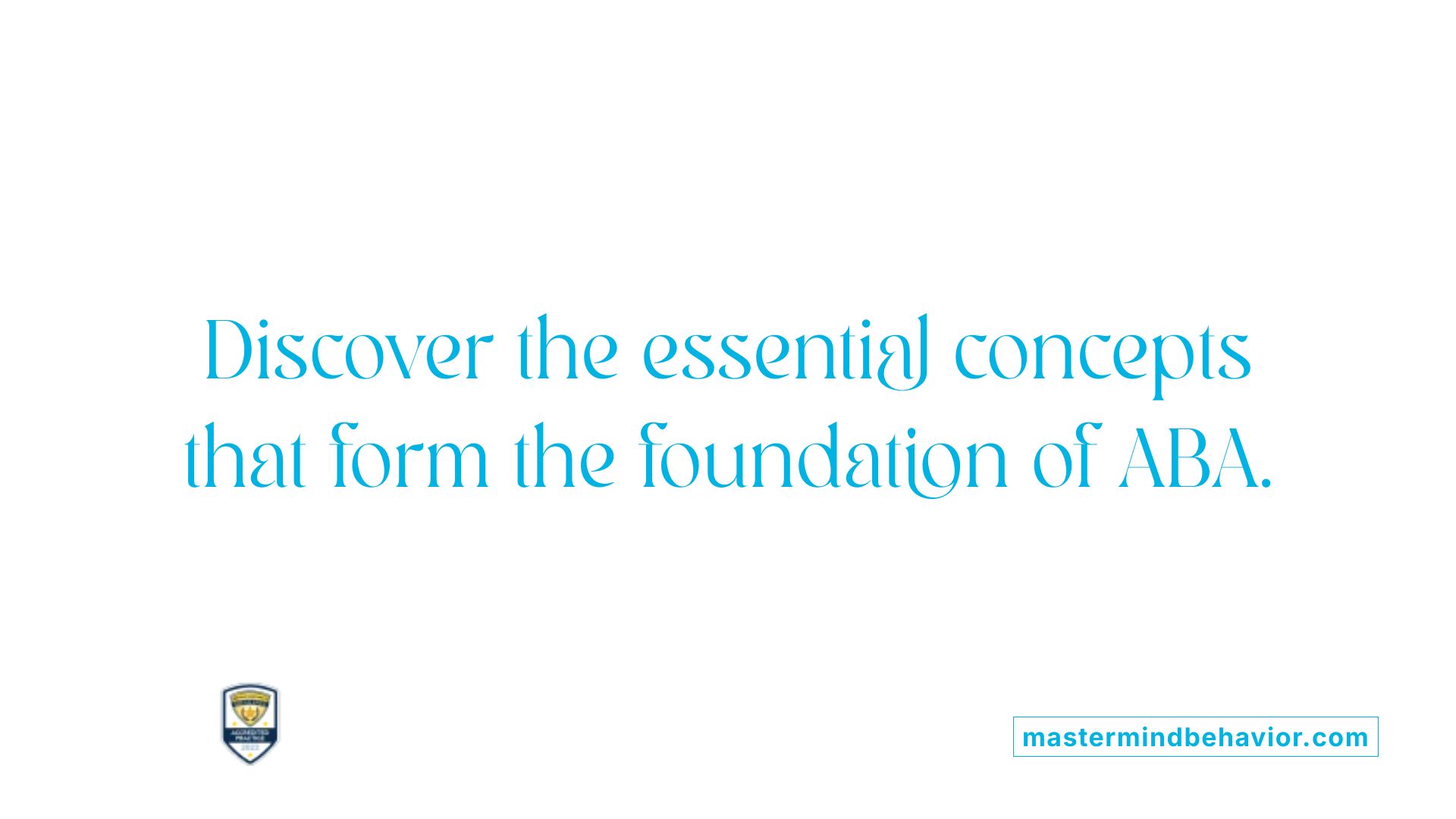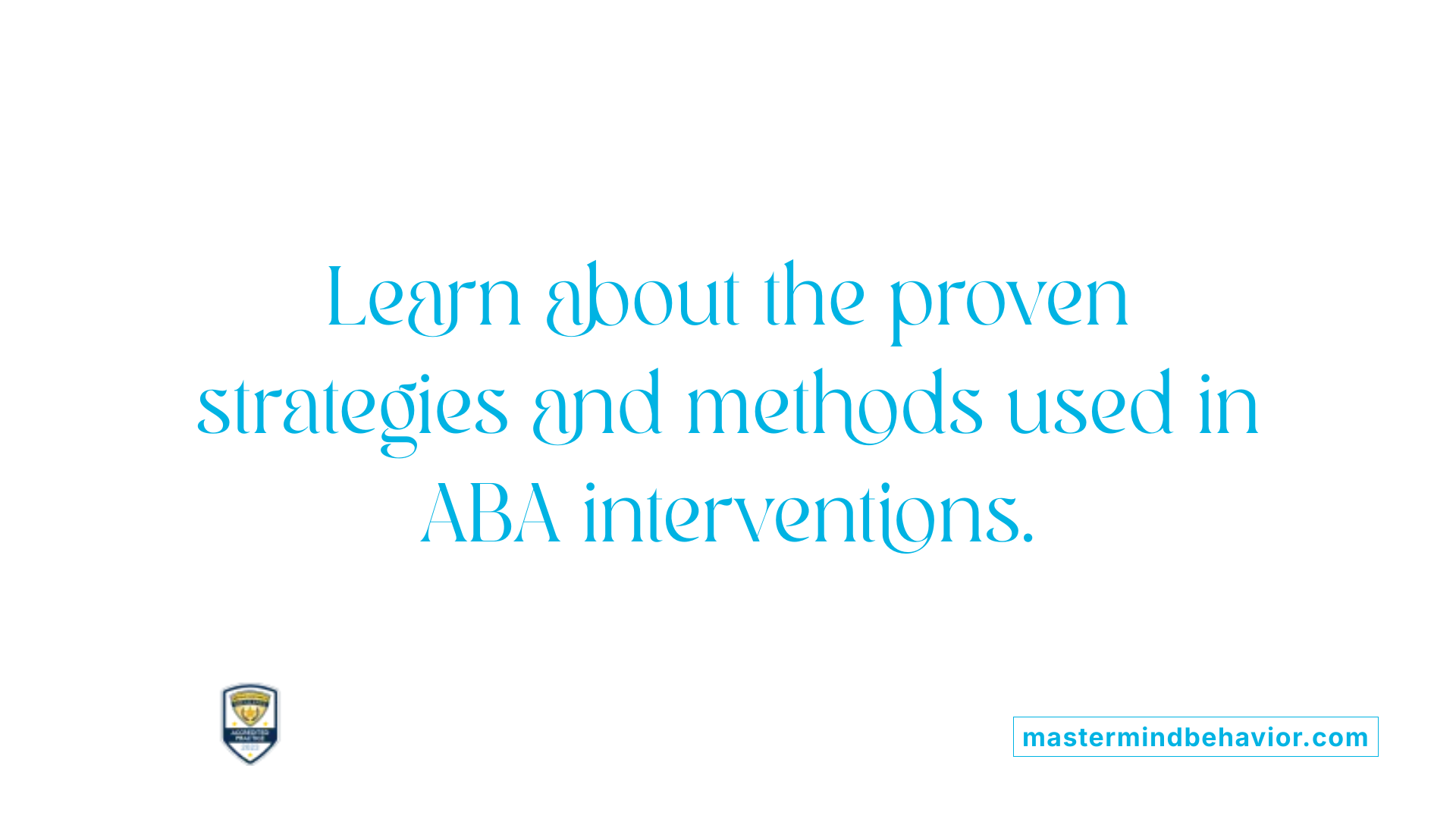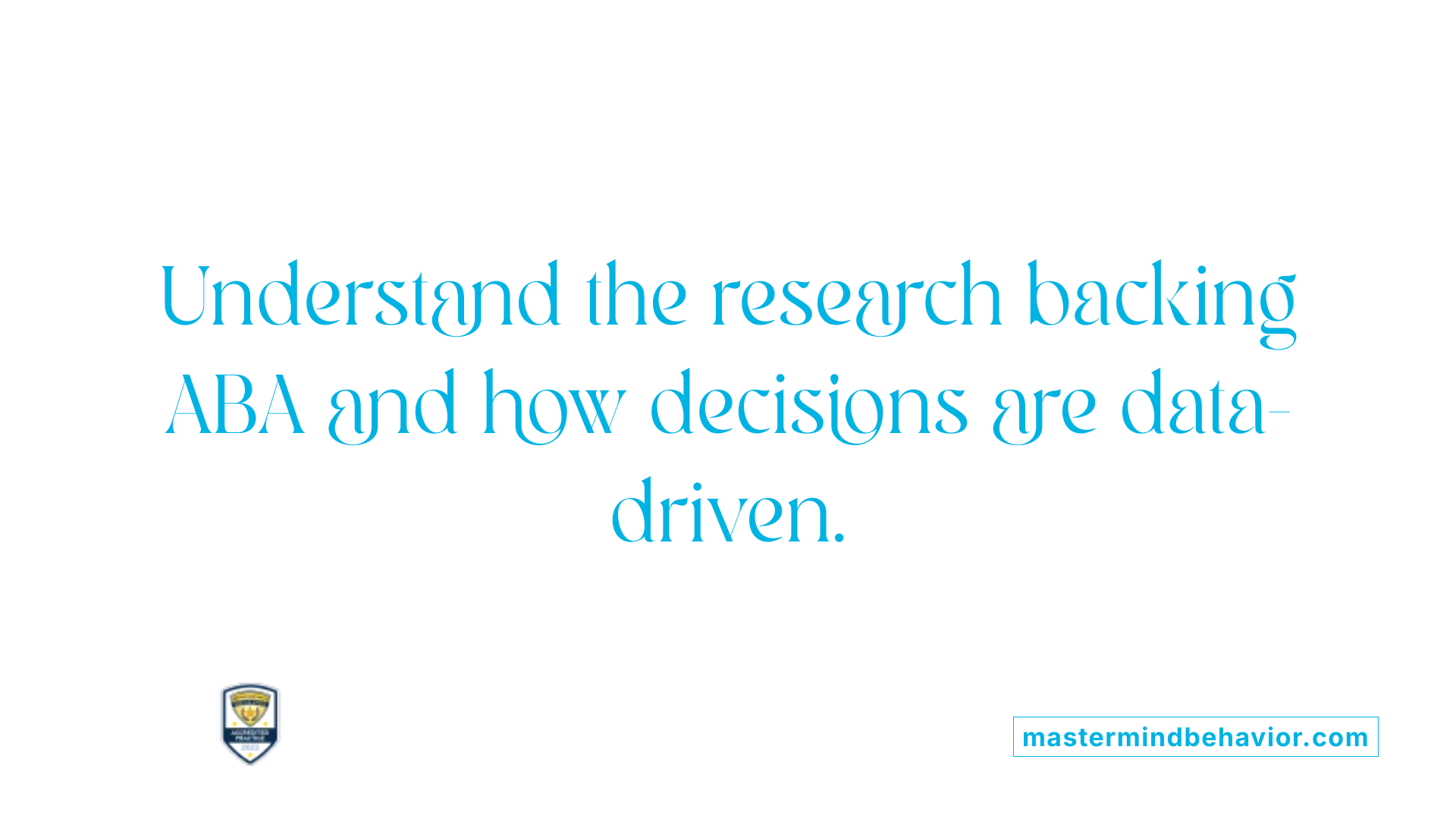Exploring the principles of applied behavior analysis

Understanding Applied Behavior Analysis: Principles and Impacts
Applied Behavior Analysis (ABA) is a scientifically grounded approach focused on understanding and modifying human behavior. Its principles are rooted in well-established learning theories, enabling practitioners to develop personalized interventions that foster meaningful behavioral change across diverse populations and settings.
Core Principles and Foundations of ABA

What are the core principles and foundational concepts of applied behavior analysis (ABA)?
Applied Behavior Analysis (ABA) is a scientific discipline that focuses on understanding and changing behavior through empirically supported techniques. Its foundation rests on several core principles including reinforcement, punishment, extinction, and stimulus control.
Reinforcement is used to increase desirable behaviors by providing rewards or removing aversive stimuli, tailored to individual preferences. Conversely, punishment aims to decrease unwanted behaviors by introducing or removing certain stimuli upon behavior occurrence. Extinction involves withholding reinforcement for specific behaviors, leading to their reduction over time.
Stimulus control refers to how environmental cues influence behavior, enabling practitioners to manipulate antecedents and consequences to modify responses.
A critical element in ABA is understanding the function of behavior, which may serve purposes such as escaping tasks (escape function), seeking attention (attention function), or obtaining tangible rewards or instant gratification (access function). Identifying these functions guides effective intervention strategies.
The three-term contingency, or ABC model, comprises Antecedent (what occurs before behavior), Behavior itself, and Consequence (what follows the behavior). This model helps analyze and influence behavior by altering antecedents and consequences.
ABA emphasizes systematic data collection and assessment to develop personalized treatment plans. Data is gathered continuously to monitor progress and make informed adjustments.
All ABA interventions are characterized by seven dimensions: Applied, Behavioral, Analytic, Conceptually Systematic, Technological, Effective, and Generality. These ensure practices are meaningful, scientifically grounded, replicable, and capable of producing lasting changes across different environments.
Overall, ABA integrates these principles to produce measurable and meaningful behavior change. It is especially effective in supporting individuals with autism but is also widely used across healthcare, education, and organizational settings to improve social skills, communication, self-help, and reduce problematic behaviors.
Scientific and Theoretical Foundations of ABA

What is the scientific basis and theoretical foundation of ABA?
Applied Behavior Analysis (ABA) is firmly grounded in the science of behavior analysis, which investigates how environmental factors influence behavior and how behaviors can be modified through systematic intervention. The core principles of ABA include classical conditioning, operant conditioning, and the three-term contingency.
Classical conditioning, originally described by Ivan Pavlov, involves learning to associate stimuli, such as a neutral stimulus becoming linked with a reflexive response. Operant conditioning, advanced by B.F. Skinner, focuses on how behaviors are shaped and maintained by their consequences—rewards or punishments—that follow the action.
A fundamental concept in ABA is the three-term contingency, which breaks down behavior into three components: the antecedent (what happens before the behavior), the behavior itself, and the consequence (what happens after). This model helps practitioners identify triggers and outcomes, enabling tailored interventions.
The scientific foundation of ABA is supported by rigorous research that emphasizes experimental validation. It relies on data collection and analysis to develop effective strategies aimed at increasing desirable behaviors and decreasing harmful ones.
Environmental influences are central to ABA’s approach. Understanding how stimuli and reinforcement patterns affect behavior allows practitioners to create environments that promote positive learning and growth.
Overall, ABA’s theoretical framework emphasizes the importance of scientifically validated methods rooted in learning theory. This ensures that behavior change strategies are effective, replicable, and tailored to individual needs, contributing to improvements in social, communication, and adaptive skills.
Techniques and Methods in ABA Therapy
 Applied Behavior Analysis (ABA) employs a range of techniques and methods designed to help individuals develop new skills and decrease problematic behaviors. One of the most structured approaches is Discrete Trial Training (DTT), which involves delivering clear, brief teaching trials that repeat specific skills, often with prompts and reinforcement to ensure mastery.
Applied Behavior Analysis (ABA) employs a range of techniques and methods designed to help individuals develop new skills and decrease problematic behaviors. One of the most structured approaches is Discrete Trial Training (DTT), which involves delivering clear, brief teaching trials that repeat specific skills, often with prompts and reinforcement to ensure mastery.
In contrast, Natural Environment Teaching (NET) adopts a more naturalistic approach, utilizing everyday situations and play to teach skills, making learning more relevant and engaging. This method emphasizes following the child's interests and spontaneous interactions.
Prompting and fading are techniques used to guide learners through new behaviors. Prompts are cues or assistance provided to encourage the correct response, and fading involves gradually reducing these prompts as independence increases.
Behavior chaining breaks down complex behaviors into smaller, manageable steps. Each step is taught and linked together until the entire behavior chain—like dressing or self-care—is performed independently.
Reinforcement strategies are central to ABA, aimed at increasing desirable behaviors. Positive reinforcement involves rewarding behaviors with praise, tokens, or preferred items, while negative reinforcement involves removing an unpleasant stimulus to encourage a behavior.
Visual modeling, scripting, and redirection are additional strategies that support learning. Visual models and scripts help clarify expectations and teach social or communication skills, while redirection shifts focus away from problematic behaviors towards more appropriate actions.
Data collection and analysis are integral to ABA, enabling practitioners to monitor progress and make data-based adjustments. This ongoing evaluation ensures that interventions are effective and tailored to each individual’s evolving needs.
Overall, ABA’s techniques are adaptable and evidence-based, focusing on systematic, measurable change that enhances skills and reduces harmful behaviors.
Application of ABA Across Diverse Settings

How are ABA principles applied in various settings and interventions?
Applied Behavior Analysis (ABA) is highly adaptable and is used across different settings such as schools, homes, clinics, and community environments. Its goal is to enhance social and academic skills while reducing challenging behaviors.
In educational environments, ABA techniques support students with various needs by promoting communication, social interaction, and academic competence. Teachers and therapists incorporate strategies like positive reinforcement, prompting, and direct instruction to help students learn and generalize skills.
Home and community-based interventions emphasize involving caregivers to ensure consistency and reinforce behaviors outside formal therapy sessions. Caregivers are trained to implement ABA principles, helping children transfer learned behaviors to everyday life.
Naturalistic teaching methods, including incidental teaching and behavior chaining, are particularly effective in real-world settings. These approaches capitalize on natural interests and routines, making learning more engaging and meaningful.
A fundamental aspect of ABA is skill generalization, where learned behaviors are applied across different situations, environments, and people. This involves using multiple exemplars, varied teaching materials, and reinforcement across settings, ensuring that behaviors are maintained over time.
Caregiver and educator involvement is crucial. Training sessions equip them with the necessary skills to apply ABA strategies consistently, which is vital for successful skill transfer and behavioral change.
Overall, ABA's flexibility enables it to address diverse needs, helping individuals increase independence and social integration in everyday life.
| Setting | Intervention Focus | Techniques Used | Outcome Goals |
|---|---|---|---|
| Educational | Academic skills, social skills, communication | Positive reinforcement, prompting, chaining | Skill acquisition, behavior reduction, generalization |
| Home and Community | Daily living skills, behavior support | Caregiver training, incidental teaching, reinforcement | Transfer of skills, behavior management |
| Clinical and Behavioral | Intensive skill training, behavior analysis | Data collection, systematic assessment | Reduce harmful behaviors, improve adaptive skills |
| Public and Social | Community participation and safety | Social stories, reinforcement, modeling | Increased independence, social interactions |
By integrating these strategies, ABA effectively promotes long-lasting, meaningful changes across many areas of an individual’s life.
Historical Development and Evolution of ABA

What is the history and development of applied behavior analysis?
Applied Behavior Analysis (ABA) has a rich history that dates back to the late 1950s and early 1960s. It emerged from pioneering research by scholars like Ayllon, Haughton, Wolf, Bijou, and Risley, who built upon earlier work by B.F. Skinner. Skinner, a central figure in behaviorism, published "The Behavior of Organisms" in 1938 and introduced radical behaviorism in 1945, laying the philosophical groundwork for ABA.
The formal recognition of ABA as a distinct discipline happened with the founding of the Journal of Applied Behavior Analysis in 1968. This marked a critical milestone, providing a platform for publishing systematic applications of behavioral principles in real-world settings.
Early ABA efforts primarily focused on using operant conditioning and reinforcement techniques to manage behaviors across diverse populations, especially children with autism. Notably, Ivar Lovaas developed intensive intervention programs in the 1960s and 1980s, which demonstrated significant improvements in communication, social skills, and behavioral regulation.
As the field progressed, ABA shifted from rigid, repetitive teaching practices toward more naturalistic and personalized methods. Modern ABA emphasizes individual needs, family involvement, and environmental context, making interventions more engaging and sustainable.
Today, ABA is recognized worldwide as a credible, evidence-based discipline rooted firmly in behavioral science. Its techniques are continually refined to improve effectiveness, cultural inclusivity, and relevance, ensuring it remains a vital tool for promoting meaningful behavioral changes across the lifespan.
Scientific Evidence and Decision-Making in ABA Practice
 Research and systematic reviews form the backbone of evidence supporting Applied Behavior Analysis (ABA). Numerous studies, including randomized controlled trials, have demonstrated ABA's effectiveness in improving key skills such as communication, social interaction, and daily living skills in children with autism spectrum disorder (ASD). Meta-analyses compile these findings, showing consistent positive effects on language development, social engagement, and adaptive behavior, though results vary for core ASD symptoms.
Research and systematic reviews form the backbone of evidence supporting Applied Behavior Analysis (ABA). Numerous studies, including randomized controlled trials, have demonstrated ABA's effectiveness in improving key skills such as communication, social interaction, and daily living skills in children with autism spectrum disorder (ASD). Meta-analyses compile these findings, showing consistent positive effects on language development, social engagement, and adaptive behavior, though results vary for core ASD symptoms.
Effectiveness and outcome measures in ABA are assessed through standardized tools and rigorous data collection methods. Behavior analysts use tools like behavior rating scales, skill assessments, and direct observation records to track progress over time. Data collection is continuous, allowing precise measurement of behavioral changes and informing decision-making.
Assessment tools, including functional behavior assessments (FBAs) and skill inventories, help identify the purpose of behaviors and individual needs. These tools guide the development of personalized intervention plans, ensuring interventions target specific, socially meaningful goals.
The integration of scientific evidence, professional expertise, and client preferences is fundamental in ABA. Practitioners combine research findings with their clinical skills and consider each individual’s values, family input, and unique circumstances to design effective treatments.
Ongoing progress monitoring allows practitioners to make data-driven adjustments. Regular analysis of behavior tracking charts enables behavior analysts to determine whether interventions are effective or need modification. This systematic approach promotes the long-term success and maintenance of behavioral improvements.
In summary, the scientific backing of ABA is robust, relying on high-quality research, standardized assessment, and systematic evaluation. While evidence indicates substantial benefits across various developmental domains, continuous research and tailored application ensure that interventions remain effective and responsive to individual needs.
The Role of Professional Judgment and Client Values in ABA

How does integration of science and practice influence ABA?
Applied Behavior Analysis (ABA) is rooted in scientific principles of learning and behavior. This means that effective ABA interventions are based on rigorous research and systematic data analysis. Practitioners utilize the best available evidence—such as scientific reviews and empirically supported techniques—to develop strategies that are proven effective.
In real-world settings, this scientific foundation guides decisions while allowing flexibility to adapt to individual needs. The integration of science and practice ensures that interventions are both effective and tailored, fostering better outcomes for clients.
Why are clinical expertise and ongoing training essential?
While scientific evidence provides the basis for ABA, clinical expertise is vital for interpreting data, customizing interventions, and responding to unpredictable behaviors. Skilled practitioners, like Board-Certified Behavior Analysts (BCBAs), use their knowledge, experience, and ongoing training to make informed decisions.
Continuous professional development helps practitioners stay updated on the latest research, techniques, and ethical standards. This ongoing learning process enhances their ability to deliver personalized, effective services and adjust strategies as needed.
How important is respecting client preferences and cultural context?
Respect for client preferences, values, and cultural background is fundamental in ABA. Tailoring interventions to align with a person’s cultural norms and individual choices increases acceptance and effectiveness. Therapists engage clients and their families in goal-setting to ensure that the behaviors targeted are meaningful and socially significant.
This collaborative approach fosters trust, motivates participation, and promotes long-lasting change. It also ensures that ABA services are sensitive to the diverse backgrounds and needs of individuals.
How does data-based decision-making support individualized care?
Data collection and analysis are at the heart of ABA practice. Practitioners use formal assessments, ongoing monitoring, and functional behavior assessments (FBA) to understand the purpose of behaviors.
Decisions about intervention adjustments are made based on systematic data, which helps in measuring progress and identifying which strategies are effective. This evidence-based, data-driven process ensures that each individual receives tailored care focused on achievable, meaningful goals.
| Aspect | Description | Role in ABA Practice |
|---|---|---|
| Integration of Science | Backing with research and evidence | Guides effective intervention strategies |
| Clinical Expertise | Skilled application and interpretation | Customizes and adjusts interventions |
| Client Values | Cultural and personal preferences | Promotes acceptance and relevance |
| Data-Driven Decision-Making | Systematic monitoring and analysis | Ensures individualized and effective care |
In summary, successful ABA involves a harmonious blend of the latest scientific findings, skilled professional judgment, respect for individual differences, and systematic, data-informed modifications. This comprehensive approach fosters ethical, personalized, and impactful behavior change.
The Future of ABA and Its Continued Significance
As the science of behavior continues to evolve, ABA remains a vital, adaptable approach that integrates empirical research, technological advancements, and person-centered practices. Its foundational principles ensure that interventions are effective, ethical, and tailored to individual needs, promising ongoing improvements across many domains and populations.
References
- What Is Applied Behavior Analysis - Exploring ABA Therapy Careers
- Applied Behavior Analysis (ABA) | Autism Speaks
- The Science of ABA: Understanding the Principles of Behavior ...
- The Science Behind ABA Therapy: Exploring its Principles with ALI
- Exploring the Principles and Practice of Applied Behavior Analysis
- The Evidence-Based Practice of Applied Behavior Analysis - PMC
- Principles of ABA - Understanding Behavior and Therapy
- The 7 Dimensions & Core Principles of ABA
- Exploring Applied Behavioral Analysis (ABA) Therapy
Recent articles

How ABA Therapy Encourages Creative Play And Imagination
Unleashing Creativity: The Role of ABA Therapy in Enhancing Play and Imagination

How ABA Therapy Supports Healthy Daily Transitions At Home
Bridging Challenges: ABA Therapy's Role in Smooth Home Transitions for Children with Autism

How ABA Therapist Uses Data To Adjust Behavior Plans
Data-Driven Insights: Shaping Effective ABA Behavior Plans

ABA Therapy For Teaching Responsibility In Managing Schedules
Harnessing ABA Therapy to Cultivate Schedule Management Skills in Children with Autism

What Families Should Know About ABA Therapy Ethics And Consent
Understanding the Foundations and Ethical Framework of ABA Therapy

How ABA Providers Can Help Teachable Moments Arise Throughout the Day
Creating Learning Moments Anywhere: The Role of ABA Providers in Everyday Development



